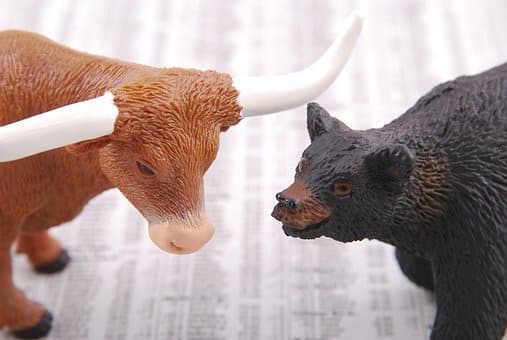Anyone new to trading Stocks, Metals, Forex, or Cryptos will quickly stumble upon a flurry of mentions of bulls and bears and their grammatical derivatives. Trading commentators might suddenly proclaim a market is bullish or be warned, momentum has turned bearish. There’s even tell of investors with bullish or bearish sentiments.
But what exactly does all this beastly jargon have to do with the cut-and-thrust world of online trading? Identifying bullish and bearish cycles is critical for any trader wanting to successfully navigate shifting market conditions and make more effective trades.
Here, we’ll delve into the origins of these trading terms, look into factors that determine bullish and bearish markets, and explore how to profit from both market conditions. 
There are two prevailing explanations surrounding the origins of the trading terms “bullish” and “bearish”.
The simplest version is that they’re shorthand for market movements based on the way these animals attack their opponents. Bulls typically thrust their horns up into the air when facing off against an aggressor, while bears swipe their paws downward. Ergo, if a financial market is on its way up, it’s called a bull market. When in decline, it’s a bear market. It couldn’t be easier to remember.
The more convoluted—and probably truer—explanation starts with a proverb that warned about “sell[ing] the bear’s skin before one has caught the bear.” Going back to the frontier days of the 18th century, selling bearskins was a common trade across the US. Bearskin jobbers were the middlemen who bought skins off traders to sell to the public. It was common for jobbers to promise bearskins to clients ahead of procurement in the hope that their sale price would fetch more than the trapper’s going rate and earn them a neat profit. This risky trading strategy could obviously backfire. If jobbers couldn’t secure bearskins for less than their selling price, they’d make a hefty loss.
This practice was later adapted in the stock market. Investors would sell borrowed stocks in the hope of buying them back for a cheaper rate at a later date. These market speculators came to be known as bears after their bearskin forebearers, and consequently, markets with falling prices were deemed to be bearish.
The bull appears to have been adopted simply because it made for a worthy counterpart to the bear. The animal imagery caught on, and bears and bulls have been a part of market trading ever since. There’s even a famous painting by William Holbrook Beard depicting a riot of bulls and bears brawling outside the New York Stock Exchange after the 1873 market crash. 
A bullish market is a financial market where prices are on the up and are expected to continue rising for some time. Many factors play into market rises, including general economic optimism, investor confidence, and forecasts claiming an uptrend could continue for weeks, months, or even years. This results in traders investing more capital within that market, resulting in a bigger rally.
Markets are considered bullish when an upward swing is established after a notable economic slump. For example, the S&P 500 enjoyed an extensive bull run between 2003 and 2007 after several years of being in decline. There are also the ever-tugging forces of supply and demand at play, especially within commodity markets. When supply is weak, there’s typically a surge in price due to high demand. This will cause the market to rise as investors compete to trade on assets few are willing to sell.
Bearish markets explained
Conversely, a bear market is when a market experiences a prolonged decline. Such downturns can be triggered by negative economic news, global crises, or national recessions. In these instances, traders often begin selling rather than buying in order to get out of losing positions, which forces the market to fall further. Like bull markets, bear markets can last for several weeks, months, or years.
After experiencing a five-year rise, the S&P 500 went into decline following the Global Financial Crisis of 2007-2008. At the time, the S&P 500 lost 50% of its value and didn’t recover until some 17 months later. Similarly, in March 2020, global stocks spiralled into bear market conditions following the outbreak of the coronavirus pandemic. This resulted in the Dow Jones falling from all-time highs in a matter of weeks. 
Understanding the factors that push markets into bullish or bearish conditions can help traders take advantage and make a profit in any market condition. By trading Contracts for Difference (CFDs), traders can profit on a market’s rise or fall by trading on the prediction of price movement rather than investing in the actual asset itself.
Profits or losses from CFD trading are based on the difference in price value of the underlying asset between the time you open and close your position. Within a bull market, the longer you hold your position means a potentially greater profit. However, if a trader anticipates a market is about to fall, they can still make a profit by opening a short sell position, which they would try to close before the market begins to recover.
When trading CFDs, traders can take advantage of market swings by opening positions with leverage. With 1:500 leverage, for example, a trader will be able to open a position worth 500 times the funds they invest in the trade. Should your trade pan out the way you anticipate, your profits will also be maximised based on your chosen leverage setting.
The profit in CFDs depends on whether a trader has correctly predicted the movement of the market as well as the change in the value of the underlying asset over the time they open and close their position. Naturally, it’s difficult to predict when a market will turn in either direction. So, a trader needs to assess the risks with a dose of good judgement to determine the optimal time to close.
Learn how to navigate bullish and bearish markets by practising on a Free Demo Account. Ready to start earning? Open a LonghornFX account and get started with a minimum deposit of just $10!
Create a LonghornFX Account: HERE
- Broker
- Min Deposit
- Score
- Visit Broker
- Award-winning Cryptocurrency trading platform
- $100 minimum deposit,
- FCA & Cysec regulated
- 20% welcome bonus of upto $10,000
- Minimum deposit $100
- Verify your account before the bonus is credited
- Fund Moneta Markets account with a minimum of $250
- Opt in using the form to claim your 50% deposit bonus
Learn to Trade
Never Miss A Trade Again

Signal Notification
Real-time signal notifications whenever a signal is opened, closes or Updated

Get Alerts
Immediate alerts to your email and mobile phone.

Entry Price Levels
Entry price level for every signal Just choose one of our Top Brokers in the list above to get all this free.



